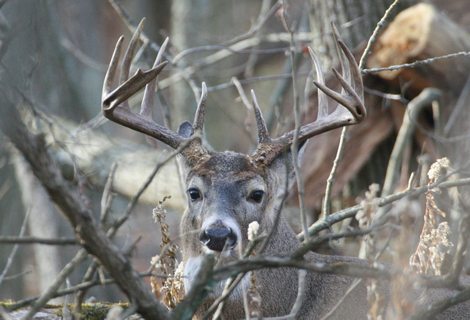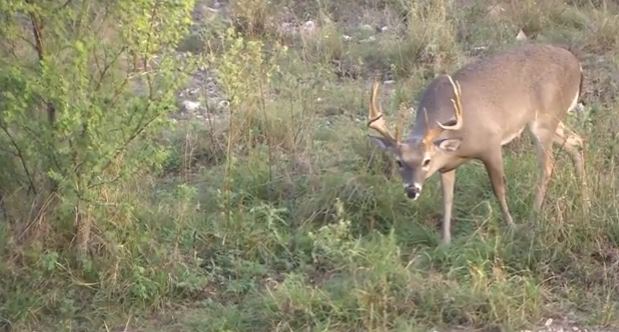When it comes to timing your deer hunting activity, every deer hunter knows that hunting during the rut is a great time to be in the woods. Sure, this can a great way to harvest a white-tailed buck because during the rut bucks can be downright stupid.
In addition to bucks having only one thing on their mind, they may stray up to several miles from their summer range in search of does or chasing does to breed. And as exciting as this may be, there is another way to bag your buck that can take some of the guess work out of the equation.

Pre-Rut Success: Pattern Bucks
The secret is patterning the movement those early season bucks way before the breeding season kicks off. Early season bucks are motivated by safety and food. Bucks feel rather safe during the early fall because for 9 months no one has bothered them — no hunters in the woods, no funny scents, no 4-wheelers running around both before and after dark, and nothing strange at all. It has been quiet.
It’s during this time of year that whitetail bucks find food sources and eat in preparation of the breeding season and winter. They may be hitting a feeder, a food plot, or an ag field, but they are all the same as far as you are concerned. If you can figure out a buck’s pre-rut pattern you drastically improve your chances of bagging that big boy.
Pre-Season: First Shot is the Best Shot
Now as I mentioned earlier the rut can cause bucks to travel long distances, so once the rut begins the buck you may have had your heart set on may no longer be in the area, so why wait? You don’t want him throwing caution to the wind somewhere else now do you?
But as easy as it is to say get out there early, early season hunting brings its own set of challenges. In addition to facing warm, maybe even hot weather, you will be heading out into the woods battling mosquitoes, chiggers, and lots of leaves that have yet to fall. Hey, I never said it would be easy even though hunting pre-rut bucks can be highly effective.
In addition to potentially tough environmental conditions, many hunters have another huge obstacle when it comes to patterning and hunting bucks early in the season. This is the fact that the rut actually occurs prior to hunting season.
This can happen in many cases. In Texas, there are many parts of the state where the general deer hunting season opens after the rut has already begun! Many hunters across the country know this fact — and in many cases it’s probably one of the important reasons they picked up a bow. In areas where the rut takes place prior to the gun (general) season, bow-hunters have the best shot at both pre-rut and early-rut bucks.
Pre-Rut Turns to Post-Rut Hunting
The rut kicking off prior the gun season opener is not unique to Texas so it’s important to know when the rut takes place in the area where you hunt, because timing can be everything. It is very difficult to pattern a pre-rut buck that’s locked into a feeding pattern when you show up a few weeks late, after the pattern has been broken.
But not all is lost, assuming that buck you are chasing is still alive. Once the whitetail breeding season is complete bucks will return to their pre-rut patterns, hitting food sources hard to replenish fat reserves before the worst of winter sets in.

However, increased hunter activity, hunting pressure, and colder weather may cause the buck to shift to a more nocturnal pattern. All of these factors contribute to a buck that is much more difficult to hunt, so take advantage of the hunting pre-rut bucks early and you will not have to hunt late.
If you remove the best bucks prior to the rut then you don’t let them pass on their genes.
Yes, you do limit that particular buck from passing on his genese himself, but not his offspring. Read this: https://www.buckmanager.com/2008/10/24/impact-of-pre-rut-buck-harvest-on-genetics/
I’m learning more everyday reading your blog. Thanks for all the hard work. I’m looking forward to more reading here!
Last year I saw three trophy class bucks together in early December. Evidently, they group back up rather quickly after the rut. Is this a common thing as most of what we read indicates that bucks remain solitary through the ensuing 2nd and 3rd rut?
For the most part, whitetail bucks do remain solitary throughout the breeding season, which usually means fall through mid-winter. However, that may not always be the case. I’ve seen a couple of bucks loosely traveling together before, but I’m not sure they are hanging out together. In addition, not all bucks go “crazy” during the rut.
Research has found that some mature bucks do not breed nearly as much as thought. I recall one Texas study where the buck to doe ratio was 1:3 and the deer density was 1 deer per 6 acres, and one of the mature bucks in the study only bred 1 doe during the entire season.